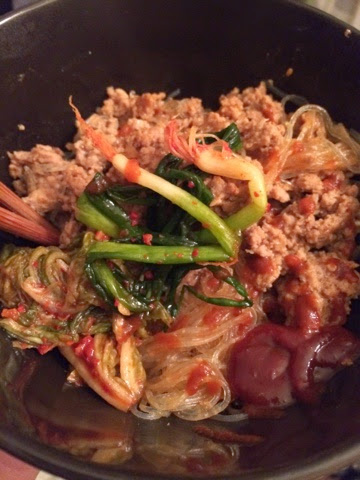I found this recipe in a travel book and the photos looked so enticing that I made it as an experiment for my entire family over Thanksgiving (that's how behind I am on my blogs!). As with many of my recipes, this is a signature dish of Korea and is widely prepared in many nearby countries because of its ease of preparation and flexibility of ingredients.
The first recorded mention of Bibimbap was in a 19th Century anonymous cookbook, and the ingredients vary depending of season, location, and station. Some historians even think that this dish originated from the historic practice of mixing food offerings together in one bowl for ancestral offering. Regardless, this dish was as fun to prepare as it was to eat.
Ingredients:
rice wine vinegar
sesame oil
soy sauce (again, I absolutely love the subtle flavor of Aloha)
fish sauce
sesame seeds
scallions
zucchini
carrot
greens (such as mustard or turnip)
wakame or other (I had to use kale prepared in a concoction of salty/fishy flavor to substitute)
dates (8-10)
ginger, minced
gochujang sauce
eggs
rice (preferably day-old)
kimchee (using my recipe posted earlier)
Modify the amount of each vegetable in accordance to your desired serving sizes. The saucy ingredients will nearly all be used to cook the solid ingredients, so I'll write instructions for each element.
Spicy Gochujang-Date Sauce:
Soak pitted dates in hot water for ~5 minutes to soften. Drain water and place in blender. Add 1 cup of gochujang sauce and blend until smooth. You can add some of the soaking water to make the sauce more silky smooth. You should be able to find Gochujang in a shop that specializes in international/asian ingredients (I like in small town Idaho and still found it, so your chances are good).
Side dishes
Carrots:
I used a potato peeler to produce long, thick ribbons of carrots that wound up having a noodle-like texture to the dish. Loved it. I used 2 large carrots for 4 people. Add your carrot noodles to a med-high heated skillet with sesame oil. Allow it to sizzle slightly, then add a sprinkle of sugar (1/4 tsp or less) and up to 1Tbsp of fish sauce or soy sauce, your choice. Remove when carrots are tender, but not completely soft. You can add a touch of chopped up ginger to this dish if you like, it's pretty tasty.
Zucchini
Slice zucchini as desired, I used small spears. Add these spears to sesame oil over med-high heat and allow them to soften. Add sesame seeds and a splash of soy sauce to finish, then remove.
Greens
Soften the greens by steaming/braising them over med-high heat with a splash of soy sauce, a touch of sesame oil, sesame seeds, and some minced ginger to taste.
Scallions
Loved, loved, LOVED this element. I'd make more next time. Thinly slice your scallions lengthwise. I cut the scallions into thirds, then sliced them in half lengthwise, then sliced itty bitty bits off of each of those. Made the work more stable. Add these thin thin slices to a shallow dish and marinate them in 1-2 Tbsp rice wine vinegar, 1/4 tsp sugar, 1/4 tsp salt.
Wakame
Not sure why I couldn't find this in my town, but if you can get your hands on some of those packages of yummy flavored "seaweed snacks" use those! You can add these to the dish at the table to give an extra layer of flavor and a slightly different texture. Just have your dinner guests crumble them over top.
Rice
Take your day old rice and pack it down into a hot hot skillet (I used a cast iron) with hot oil (I used grapeseed oil so it wouldn't burn). Allow the bottom to sear until crispy-- don't pack it so thick that the rest of your rice is cold while the part in the pan is burnt. Cut into pie-shape slices, or whatever works, and place these on the bottom of your serving bowls.
Sesame seeds
If you can't buy toasted sesame seeds, just toast some up in a dry pan.
Eggs
The eggs should be prepared sunny-side up and are the second element to enter your serving bowls. This signals the beginning of the meal!
I divided the vegetable elements onto each diner's accompanying plate (not the eating bowl) and the others were displayed in their own dishes. Your dinner guests have the joy of making their own dinners. The spicy sauce is usually placed along one edge of the bowl so the diners can dip each bit into it as they wish.
Can't wait to make this one again! It was so fun to make everything with my family-- it is definitely a dish that requires a lot of preparation before cooking. You can make all sorts of changes to the recipe by using leftover meats, fish, extra vegetables, etc. Have fun with this one!














